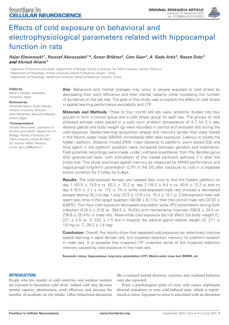Scientific papers 2014





Bruce Wienke (1940 - 2020) was the Program Manager in
the United States of America Nuclear Weapons
Technology Simulation And Computing Office at the Los
Alamos National Laboratory. He worked on
decompression, gas transport, and phase mechanics.
He published numerous documents related to
decompression models and contributed to many
workshops. He also developed algorithms for
decompression computers, notably those used by the
brand “Suunto”.
In this article, he made a status of the existing
decompression models used for diving applications and
their impact on these activities.


Magnetic Resonance Imaging (MRI) is currently the most
accurate neuroimaging technique available for detecting
brain and spinal cord lesions in neurologic type 2
decompression sickness.
Some typical results are summarized and illustrated in this
article.
Also, the authors review the limitations of previous work
and make practical methodologic suggestions for future
neuroimaging studies.
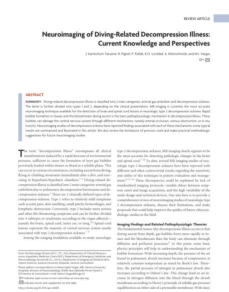


Authors:
Antonino Baez, Joseph Shiloach, Tadeusz Doboszynski.
The response of bacteria, yeast, and mammalian and
insects cells to oxidative stress is a topic that has been
studied for many years. However, in most reported
studies, the oxidative stress was caused by challenging the
organisms with H2 O2 and redox-cycling drugs but not
by subjecting the cells to high concentrations of
molecular oxygen. In this review, the authors summarize
the available information about the effect of elevated
oxygen concentrations on the physiology of
microorganisms and cells at various culture conditions.
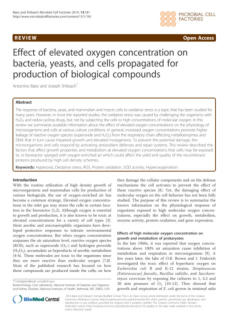

Authors: Danilo Cialoni, Massimo Pieri, Costantino
Balestra, and Alessandro Marroni,
Introduction:
Flying after diving may increase decompression sickness
risk (DCS), but strong evidence indicating minimum
prefight surface intervals (PFSI) is missing.
Methods:
On return flights after a diving week on a live-aboard, 32
divers were examined by in-flight echocardiography with
the following protocol: outgoing flight, no previous dive;
during the diving week; before the return flight after a 24-
h PFSI; and during the return flight.


Authors:
Lesley Blogg, Mikael Gennser, Andreas Møllerløkken, and
Alf O Brubakk
Introduction:
Diving often causes the formation of ‘silent’ bubbles upon
decompression. If the bubble load is high, then the risk of
decompression sickness (DCS) and the number of
bubbles that could cross to the arterial circulation via a
pulmonary shunt or patent foramen ovale increase.
Bubbles can be monitored aurally, with Doppler
ultrasound, or visually, with two-dimensional (2D)
ultrasound imaging. Doppler grades and imaging grades
can be compared with good agreement. Early 2D
imaging units did not provide such comprehensive
observations as Doppler, but advances in technology
have allowed the development of improved, portable,
relatively inexpensive units. Most now employ harmonic
technology; it was suggested that this could allow
previously undetectable bubbles to be observed.
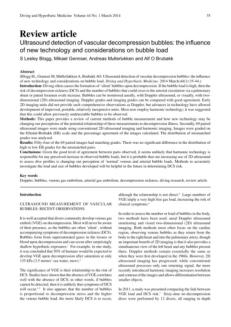

Authors:
Emmanuel Gempp, Pierre Louge, Sébastien De Maistre,
Loïc Emile and Jean-Eric Blatteau.
Neuron-specific enolase (NSE) and S100B protein are
brain-origin proteins commonly described to assess the
presence and severity of the neurological injury. To date,
limited data are examining the influence of scuba diving
on these biomarkers, particularly when symptoms of
decompression sickness (DCS) occur. The purpose of this
controlled study was to determine whether these serum
neurochemical markers could be used as indicators of
neurological DCS and predictors of incomplete recovery.
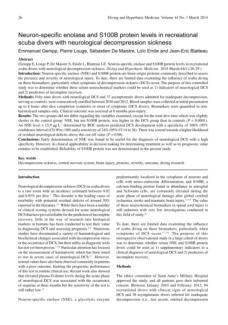

Authors:
Abu Shamsuzzaman, Michael J. Ackerman, Fatima Sert
Kuniyoshi, Valentina Accurso, Diane Davison, Raouf S.
Amin, and Virend K. Somers.
This study aimed to develop a simple and practical
method for simulating diving in humans using facial cold
exposure and apnea stimuli to measure neural and
circulatory responses during the stimulated diving reflex.
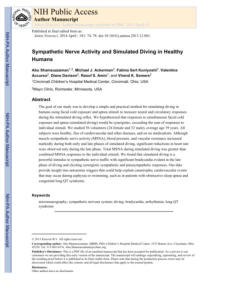

Authors: Damien Fouan, Younes Achaoui, and Serge
Mensah.
A microbubble sizing method based on the odd
harmonics of square-like excitations is presented. The
microbubble resonance signature is determined by
measuring the backscattered signals using the Dual
Frequency Method combined with a time-frequency
representation. This method's efficiency and limitations are
described in the case of sine-like excitations.


Authors: Stephen R. Thom, Veena M. Bhopale, and Ming
Yang.
Microparticles are generated in vivo with exposures to
high-pressure gases by unclear mechanisms. As a result,
high inert gas pressure causes singlet oxygen formation,
which initiates a cycle of actin S-nitrosylation, nitric-oxide
synthase-2, and NADPH oxidase activation leading to
microparticle formation.
In conclusion, Inert gas-mediated oxidative stress causes
microparticle production, which may initiate events
leading to decompression sickness.
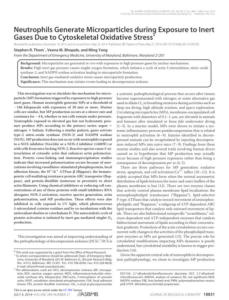

Authors: Virginie Papadopoulou, Meng-Xing Tang,
Costantino Balestra, Robert J. Eckersley, Thodoris
D. Karapantsios.
In contrast to decompression-induced bubbles, whose site
of initial formation and exact composition are debated,
there are other instances of bubbles in the bloodstream
which are well-defined. Gas emboli unwillingly introduced
during surgical procedures and ultrasound microbubbles
injected for use as contrast or drug delivery agents are
therefore also discussed. After presenting the different
ways that bubbles can end up in the human bloodstream,
the general mathematical formalism related to the physics
of bubble growth and detachment from decompression is
reviewed.
.


Authors: Jason M. Valadao, John A. Vigilante, Nicholas W.
DiGeorge, Sunila E. O’Connor, Alexandria Bear,
Jeffrey Kenyon, Heather Annis, Joseph Dituri,
Amy E. Dituri, Harry T. Whelan.
A ketogenic diet (KD) may decrease central nervous
system oxygen toxicity symptoms in divers. In view of this
implication, a feasibility/toxicity pilot study was performed
to demonstrate tolerance of KD while performing normal
diving profiles.
.
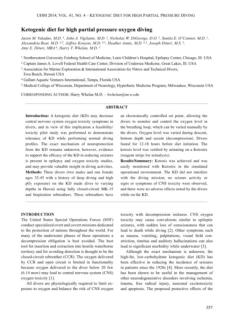

Authors:
Pieter-Jan Van Ooij, R.A. van Hulst, W. Kulik, P. Brinkman,
A. Houtkooper, P.J. Sterk
Exhaled breath contains volatile organic compounds
(VOCs) associated with respiratory pathophysiology. The
authors hypothesized that hyperbaric oxygen exposure
(hyperoxia) generates a different VOC pattern.
This study aimed to test this hypothesis in oxygen-
breathing divers.
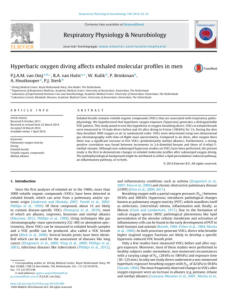

Authors:
Antonio Ayala, Mario F. Muñoz, and Sandro Argüelles
Lipid peroxidation can be described as a process under
which oxidants such as free radicals attack lipids
containing carbon-carbon double bond(s), especially
polyunsaturated fatty acids. Extensive literature regarding
lipid peroxidation has shown its essential role in cell
biology and human health. Discoveries about the
involvement in cellular physiology and pathology, as well
as the control of lipid peroxidation, continue to emerge
every day.
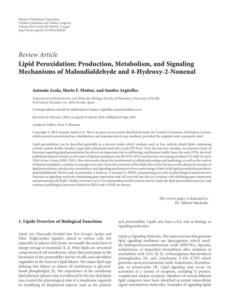

Publisher: Undersea and Hyperbaric Medical Society
This document from the Undersea and Hyperbaric
Medical Society , published in 2014, provides guidance
and support for scientists and practitioners of hyperbaric
oxygen therapy.
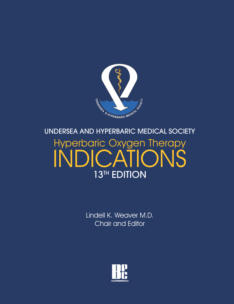

Authors:
Romuald Olszanski, Piotr Radziwon, Jolanta Korsak, Piotr
Siermontowski, Mariusz Kozakiewicz
Gas bubbles occurring during decompression create a
non-physiological surface that comes into contact with
blood platelets and coagulation proteins. The result is the
activation of blood platelets and contact factors.
Accordingly, over 30 years ago, Polish researchers began
verifying the safety of decompression tables by evaluating
changes in homeostasis and fibrinolysis.
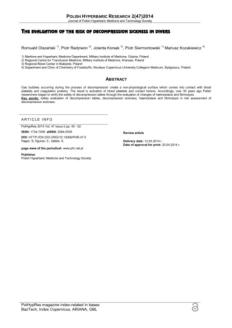

Authors:
Christopher Matthew Norton Earing, Damian John
McKeon, Hans-Peter Kubis
Two studies were performed to investigate the ventilatory
response to CO 2 in hyperoxia, hypoxia, and during
exercise amongst experienced scuba divers and matched
controls.
The first investigated the CO2 sensitivity in rest and
exercise using CO2 rebreathing in hyperoxia at a
workload typical for diving with divers and controls. The
second study examined the respiratory drive of divers and
controls whilst breathing four different gas mixtures
balanced with N2 to assess the combined response to
hypercapnia and moderate hypoxia.
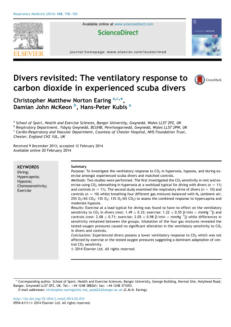

Authors: Richard E. Moon, Simon Mitchell
The use of oxygen with pressure to accelerate gas
diffusion and bubble resolution in humans was first
suggested in 1897 and eventually tested in the 1930s for
human DCS and recommended for treatment of divers.
It is also likely that hyperbaric O2 has other beneficial
pharmacological effects such as a reduction in neutrophil
adhesion to the capillary endothelium.
The efficacy of hyperbaric O2 is now widely accepted,
and is the main stay of treatment for this disease.
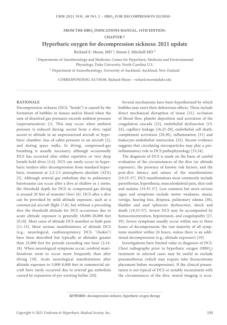

Authors: J.C. Rostain, N. Balon
Compressed air or a nitrogen-oxygen mixture produces
from 0.3MPa nitrogen narcosis. The traditional view was
that anaesthesia or narcosis occurs when the volume of a
hydrophobic site is caused to expand beyond a critical
amount by the absorption of molecules of a narcotic
gas. The observation of the pressure reversal effect on
general anaesthesia has for a long time supported the
lipid theory. However, recently, protein theories are in
increasing consideration since results have been
interpreted as evidence for a direct anaesthetic-protein
interaction.
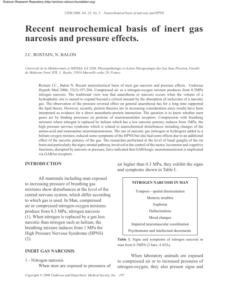

Click on the octopus
to return to the top
of the page



Authors: J.G. Swan, J.C. Wilbur, K.L. Moodie, S.A. Kane,
D.A. Knaus, S.D. Phillips, T.L. Beach, A.M. Fellows,
P. J. Magari, and J. C. Buckey
This study aimed to determine whether microbubbles
could be found in blood vessels and if they preceded
larger venous gas embolisms (VGE). Fifteen anesthetized
pigs underwent a 2-hour high-pressure exposure,
followed by decompression. Results showed that
microbubbles appeared in the bloodstream immediately
after decompression, with or without VGE. Without VGE,
microbubbles persisted throughout the hour, whereas
with VGE, they initially appeared but dissipated. No
microbubbles were observed in the control sham dives.
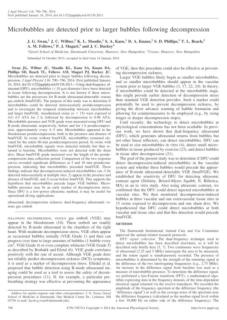

Authors: Konstantinos Tasios, Georgios G Sidiras, Vasileios
Kalentzos and Athina Pyrpasopoulou
A probable case of decompression sickness with skin
mottling improved with oxygen and treatment, but the
patient was later transferred for specialized care. Although
skin symptoms are not typically fatal, prompt identification
is crucial as they may indicate significant risks. An allergic
reaction is also a potential diagnosis in this case.
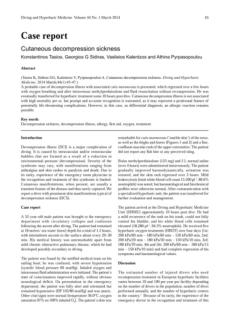

Authors: David J Doolette, Keith A Gault, and Christian R
Gutvik
Studies that use venous gas emboli (VGE) as an outcome
measure require careful design to ensure adequate
power to detect significant differences. A comparison of
two decompression schedules indicated a link between
VGE grades and decompression sickness (DCS) incidence,
emphasizing the importance of sample size. The results
showed that a minimum of 50 subjects are needed to
achieve about 80% power, while fewer than 30 subjects
significantly reduce power below 50%. Thus,
comparisons made with fewer than 30 subjects should
be approached cautiously, and a sample size of 50 is
recommended for robust study results.


Authors:
Peter Germonpré, Virginie Papadopoulou,
Walter Hemelryck, Georges Obeid, Pierre Lafère, Robert J
Eckersley, Ming-Xing Tang and Costantino Balestra
Decompression stress is typically assessed by counting
bubbles in the bloodstream after a dive using Doppler or
cardiac echography. This data helps develop safer
decompression practices by linking fewer bubbles to a
reduced risk of decompression sickness. The researchers
considered that the Eftedal and Brubakk method for
evaluating these bubbles has limitations and introduced a
new "frame-based" counting method that provides a
continuous measurement scale.
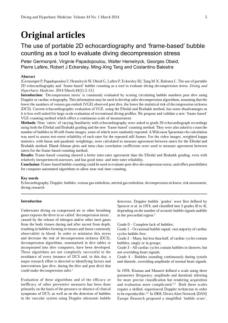

Authors: Philippa Welfare, Mark Little, Peter Pereira, and
Jamie Seymour
This study aimed to determine the effects of acetic acid
(vinegar) on the release of nematocysts during a
simulated sting caused by Chironex fleckeri (also known
as the box jellyfish). The results suggest that vinegar
promotes the further release of venom from nematocysts
that were previously discharged. This raises concerns that
vinegar may be harmful as a first-aid treatment for
Chironex fleckeri stings.
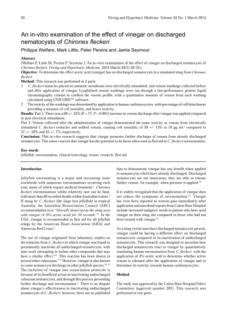

Author: Ross Di Colerto
Staying hydrated is crucial for managing heat-related
illnesses. Measuring individual fluid levels is helpful in
assessing heat stress. Traditionally, this involves weighing
someone before and after exposure to determine fluid
loss, although it's not always convenient and requires
ongoing record-keeping. Nowadays, measuring urine
specific gravity (SG) has become a popular method for
monitoring hydration. But how accurate and effective is
this method for managing heat stress?
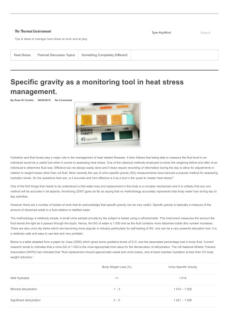

Authors: Zeljko Dujk, Davor Eterovic, Pero Denoble, Goran
Krstacic, Jadranka Tocilj
A rebreathing method has been developed to measure
the lung's diffusing capacity for carbon monoxide (DCO)
in hyperbaric conditions. The study included 22 naval
divers with normal lung function. Strong correlations were
found between rebreathing and single-breath
measurements for DCO, alveolar volume (VA), and
DCO/VA. Measurements were taken before, during, and
after a dive in a controlled environment, following the US
Navy decompression protocols.
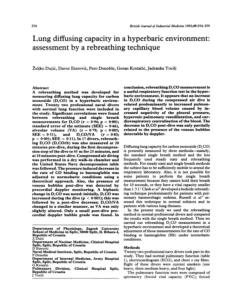

Publisher: Sami F. Khalil, Mas S. Mohktar, Fatimah Ibrahim
This paper explores various bioimpedance measurement
techniques, including frequency-based, allocation-based,
vector analysis, and real-time systems. The method
discusses prediction equations for body composition,
taking into account factors such as anthropometry,
gender, ethnicity, posture, protocol, and electrode
artifacts. Additionally, the paper addresses bioimpedance's
role in detecting abnormal lean mass loss and fluid
imbalances and its diagnostic applications in cardiac,
pulmonary, renal, neural, and infectious diseases.
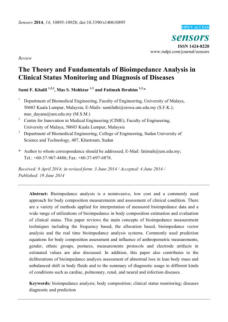



Authors:
M. Gronning, J. Risberg, H. Skeidsvoll, G. Moen, L.
Aanderud, K. Troland, E. Sundal, E. Thorsen
This study evaluated the effectiveness of
electroencephalography (EEG) and magnetic resonance
imaging (MRI) in diagnosing acute decompression
sickness (DCS) in the central nervous system (CNS). It
determined the utility of these diagnostic tools in clinical
settings and concluded that both EEG and MRI have low
sensitivity for diagnosing acute DCS in the CNS. The study
authors also suggest that recompression treatment for
DCS should continue to be guided primarily by clinical
neurological examinations and symptom assessments.
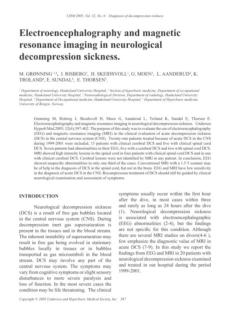

Author: Peter Buzzacott, Aleksandra Mazur, Qiong Wang,
Kate Lambrechts, Michael Theron, Jacques
Mansourati, and François Guerrero.
This paper discusses the findings of a study that evaluated
the reliability of using a tilting-board grip score to measure
decompression sickness in rats. The study involved a
hyperbaric compression/decompression protocol,
observations for signs of decompression sickness, and
their grip strength measured on a tilting particle board
hinged to a metal frame. The results indicated a significant
association between decreased grip scores and the
probability of decompression sickness, suggesting that the
tilting-board grip score is reliable for assessing
decompression sickness in rats.
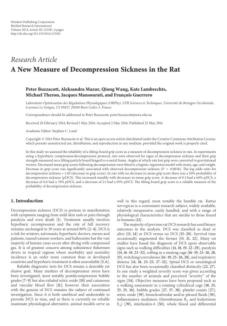

Authors:
Ian C Gawthrope, David A Playford, Benjamin King,
Kathryn Brown, Catherine Wilson and Barry McKeown
This study evaluated the cardiac changes occurring
during hyperbaric oxygen (HBO) therapy using
transthoracic echocardiography (TTE) in subjects without
active cardiac disease and determined whether HBO has
adverse effects on cardiac physiology. It concluded that
TTE can be safely performed within a hyperbaric chamber
and that HBO does not adversely affect cardiac
physiology in individuals without active cardiac disease.
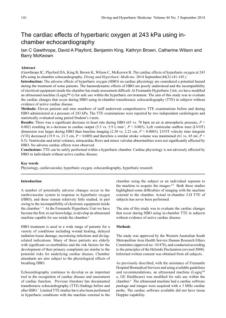

Authors: Laura Lamprell, Derelle Young, Venkat
Vangaveti, John Orton and Anand Suruliraj
This paper presents a study that investigates the
differences between patients receiving hyperbaric oxygen
treatment (HBOT) and concurrent grommet insertion
under local anesthesia (LA) versus general anesthesia
(GA) at The Townsville Hospital (TTH). It compares the
safety, timing, and outcomes of grommet insertion under
these two types of anesthesia in the context of HBOT-
associated middle ear barotrauma (MEBT).
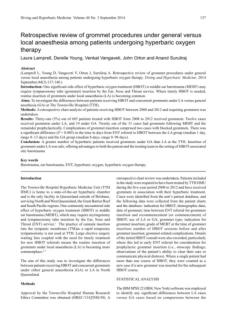

Authors: David R Smart, Corry Van den Broek, Ron Nishi,
David Cooper and David Eastman
This study assessed the risk factors for decompression
illness (DCI) among aquaculture divers in Tasmania. It
aimed to determine if repetitive, short-duration bounce
dives (yo-yo dives) were a risk factor for DCI, identify dive
profiles with acceptable risk, and investigate ways to
improve productivity. The results indicated that bounce
diving was not a major factor causing DCI, and the
analysis led to improved industry productivity by increasing
the permissible number of bounces without
compromising safety. The study also provided
recommended guidelines for bounce diving to a depth of
21 msw.
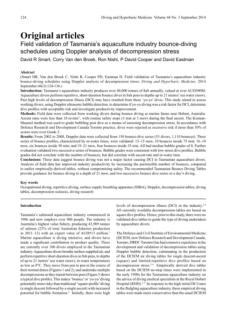

Authors: Rasool Zarezadeh and Mohammad Ali
Azarbayjani
This study investigated the effects of environmental
pressure changes with depth on serum cortisol levels in
the body. It specifically examined how cortisol levels
change after air scuba dives at various depths in open
water. The text details the methodology, results, and
conclusion of the study, highlighting that cortisol levels
increased with immersion and were significantly higher at
greater depths. This suggests that these changes are due
to the physiological effects of immersion and increased
environmental pressure.
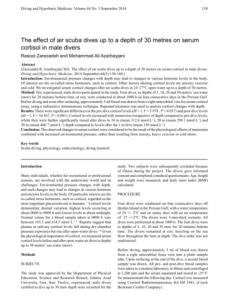

Authors: Natalie A. Masento, Mark Golightly, David T.
Field, Laurie T. Butler and Carien M. van Reekum
This document reviews and integrates recent research
findings on the effects of water consumption and
dehydration on cognitive abilities and mood. It highlights
the positive influence of water on brain function,
particularly in vulnerable populations like the elderly and
children. The text also seeks to identify methodological
weaknesses in current studies and suggest future research
directions to understand better the mechanisms by which
water affects brain health and function.
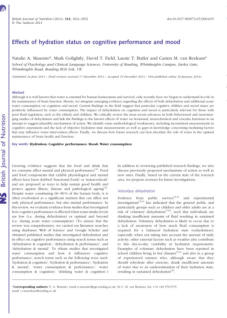

Authors: Costantino Balestra
This document discusses the potential mechanisms and
pathways for the formation and transport of microbubbles
in the body following decompression. It examines various
hypotheses about where and how these microbubbles
form, proposing the lymphatic system as a possible
transport mechanism that could explain the detection of
vascular gas emboli over extended periods. Additionally, it
refers to findings and studies related to preventing
decompression sickness, suggesting that whole-body
vibration before a dive may reduce post-dive bubble
formation through mechanical dislodgement or
enhanced lymphatic elimination of gas nuclei.
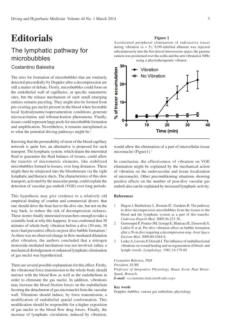

Authors: R. Arieli, A. Marmur
The aim of this paper is to present scientific observations
and findings related to the formation and behavior of
nanobubbles and gas micronuclei on hydrophobic
surfaces and ovine blood vessels during decompression. It
highlights a new discovery of active spots where bubbles
nucleate and suggests the need for further exploration of
the potential neurological effects of large arterial bubbles.
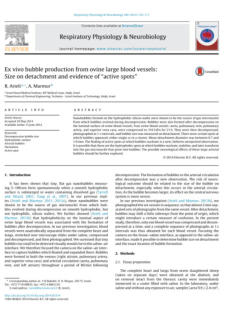



7 - A retrospective cohort study of lidocaine in divers with
neurological decompression illness

Authors: Robert P. Weenink, Markus W. Hollmann, Astrid
Zomervrucht, Pieter-Jan A.M. van Ooij, Robert
A. van Hulst
Lidocaine is the most studied treatment for neurological
decompression illness (DCI), but results are mixed. This
retrospective study compared 14 patients treated with
intravenous lidocaine to 21 who did not receive it. Both
groups had similar injury severity and HBO2 sessions.
Lidocaine showed no clear effect on outcomes. A larger,
prospective study is needed to clarify lidocaine's role in
DCI.




25 - Decompression tables for inside chamber attendants working at
altitude.

Author: James Bell, Paul A. Thombs, William J. Davison,
Lindell K. Weaver
This document investigates whether hyperbaric oxygen
(HBO2) multiplace chambers inside attendants (IAs) are at
risk for decompression sickness (DCS) at altitude as
standard decompression tables are formulated for sea-
level use, not for use at altitude.
The results suggest that chamber attendants' risks for DCS
at increased altitudes are low when they breathe
supplemental
oxygen.
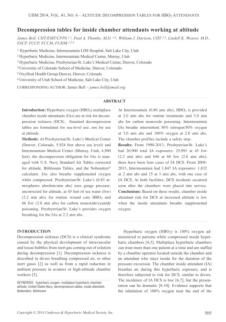


2 - IA note on arterial to venous oxygen saturation as reference for
NIRS-determined frontal lobe oxygen saturation in healthy
humans

Author: Henrik Sørensen, Niels H. Secher and Peter
Rasmussen
Near infrared spectroscopy (NIRS) is a non-invasive
method for assessing oxygenation in the human brain
(ScO2) by analyzing the absorption of near-infrared light
by hemoglobin and oxygenhemoglobin. However, the
signal's length from the skin to the cortex and back is
unknown, and most devices use a fixed reference ratio.
This assumption may be confounded by changes in
cerebral blood volume during hypoxia and changes in
arterial carbon dioxide tension.
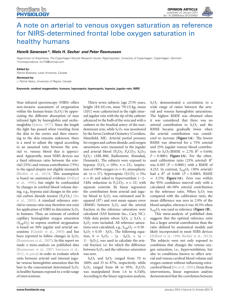


6 - Cerebral oxygenation and hyperthermia

Author: Anthony R. Bain, Shawnda A. Morrison, and
Philip N. Ainslie
Hyperthermia reduces cerebral blood flow (CBF) due to
increased cardiac output distribution, alveolar ventilation,
and hypocapnia. The hyperventilatory response reduces
arterial CO2 pressure, causing cerebral vasoconstriction
and reduced flow. In passive hyperthermia, PaCO2
reductions may be the primary cause. Dynamic
conditions, like hemorrhage or orthostatic challenges,
may compromise cerebral perfusion pressure due to
systemic blood pressure reductions. This review explores
the mechanisms governing changes in CBF and
oxygenation during moderate to severe hyperthermia
levels.
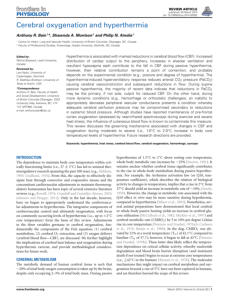
Author: Ben Aviner, Gideon Gradwohl, Merav Mor
Aviner, Shiri Levy, and Yoram Grossman
High Pressure Neurological Syndrome (HPNS) is a motor
and cognitive impairment experienced by deep sea
divers when exposed to pressures of 100 msw or higher.
This condition is influenced by synaptic transmission
alteration and pressure effects on voltage-dependent
Ca2+ channels in Xenopus oocytes.


13 - Selective modulation of cellular voltage-dependent calcium
channels by hyperbaric pressure—a suggested HPNS partial
mechanism
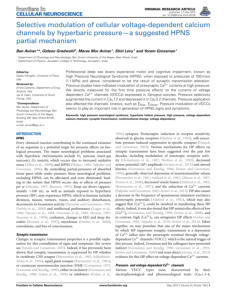



17 - Memory and Metacognition in Dangerous Situations:
Investigating Cognitive Impairment From Gas Narcosis in
Undersea Divers

Authors: Malcolm Hobbs, Philip A. Higham, Wendy
Kneller
The study investigated if underwater divers can
accurately assess their memory impairment from inert
gas narcosis. The research found that both free-recall
and cued-recall performance were significantly reduced
in deep conditions, with an increase in self-assessed
impairment. However, resolution remained unaffected
by depth. The study concluded that impaired self-
assessment and resolution may not be a symptom of
narcosis in the depth range of 33 to 42 m underwater,
suggesting that divers are better equipped to manage
narcosis than previously suggested.
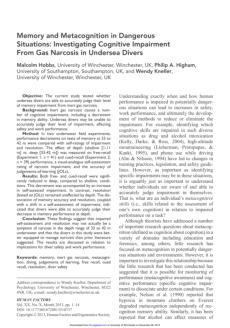



29 - Effects of cold exposure on behavioral and electrophysiological
parameters related with hippocampal function in rats

Author: Hajar Elmarzouki, Youssef Aboussaleh, Soner
Bitiktas, Cem Suer, A. Seda Artis, Nazan Dolu,
and Ahmed Ahami
This study investigates the impact of cold stress on spatial
learning performance, excitability, and long-term
potentiation (LTP) in rats. Three to four-month-old rats
were divided into control and cold stress groups, and
exposed to cold for two hours a day. The rats were
tested in the Morris water maze (MWM) and their spatial
learning and memory performance were compared.
Results showed that cold-exposed female rats needed
less time to find the hidden platform, while cold-exposed
male rats showed decreased escape latency. Cold
exposure also decreased population spike potentiation in
male rats.
